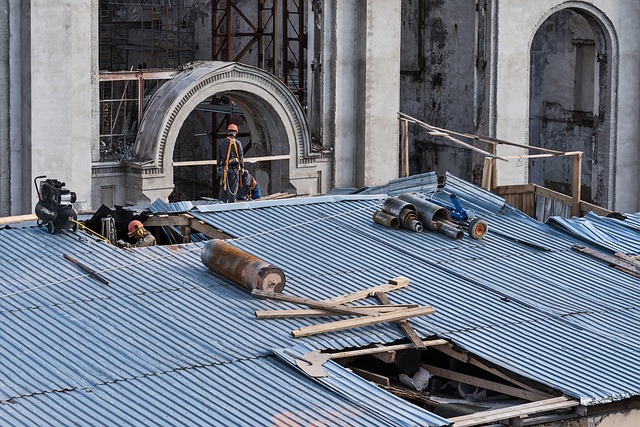In the fast-paced construction sector, temporary roofing is an essential solution for protecting sites and structures from weather and environmental damage during various stages of building projects. Prioritizing robust, secure installation with resistant materials and modular designs speeds up timelines while ensuring site safety. Safe installation practices include proper training, gear, inspections, adherence to guidelines, and efficient fastening. Eco-friendly alternatives like recyclable composite fabrics minimize environmental impact without sacrificing durability. Adopting these innovations promotes green building practices while maintaining quality and safety standards.
Secure temporary roofing is an essential component of any construction project, offering a robust solution for protecting sites during building processes. This article delves into the critical need for temporary roofing in construction, highlighting key features that ensure durability and safety. We explore installation best practices, safety considerations, and environmental impacts, providing insights on sustainable options for efficient projects while emphasizing the importance of secure temporary roofing.
- Understanding the Need for Temporary Roofing in Construction
- Key Features of Secure and Durable Temporary Roof Systems
- Installation and Safety Considerations for Efficient Projects
- Environmental Impact and Sustainable Options for Temporary Roofing
Understanding the Need for Temporary Roofing in Construction
In the fast-paced world of construction, where projects are often time-sensitive and multifaceted, the need for secure and reliable temporary roofing cannot be overstated. Temporary roofing solutions play a pivotal role in safeguarding construction sites from the elements, ensuring worker safety, and preserving the integrity of ongoing projects. These structures provide a much-needed buffer between the bustling activity below and the unpredictable weather conditions above.
Construction sites, by their very nature, are dynamic environments with constant comings and goings. Traditional roofing methods might not offer the flexibility required to accommodate these changes. Here’s where temporary roofing excels—it offers a quick, efficient, and cost-effective way to cover and protect essential areas, be it during the initial preparation stages, while permanent structures are being designed and built, or in case of unforeseen delays due to weather conditions.
Key Features of Secure and Durable Temporary Roof Systems
When selecting a temporary roofing system for construction projects, key features to consider include robust durability and secure installation. These systems must withstand harsh weather conditions and the constant movement associated with building sites, ensuring the safety of workers and the preservation of the underlying structure. Look for materials that are resistant to high winds, heavy rain, and UV rays, providing a reliable shield until the permanent roof is in place.
Additionally, a secure and versatile temporary roofing solution should offer easy installation and removal. Modular designs that can be quickly assembled and disassembled by skilled workers or even unskilled labor, with minimal tools, are highly advantageous. These systems often feature locking mechanisms and anchor points to ensure stability during transit and when exposed to extreme conditions. Such features not only speed up construction timelines but also guarantee the overall integrity of the temporary roof.
Installation and Safety Considerations for Efficient Projects
When installing temporary roofing for construction projects, safety should be the top priority. Proper training and equipment are essential for all workers involved to prevent accidents and ensure a secure environment. Using approved safety gear, such as hard hats, high-visibility clothing, and fall protection systems, is crucial during the setup process. Regular site inspections are also vital to identify potential hazards and address them promptly.
Efficient installation practices involve following manufacturer guidelines for all materials and utilizing appropriate tools. This includes proper fastening techniques, sealing to prevent leaks, and securing roofs against wind and other elements. Well-planned layouts and clear communication among the team contribute to a seamless setup process. Regular maintenance checks are equally important to keep the temporary roofing in good condition throughout the project duration, ensuring safety and minimizing disruptions.
Environmental Impact and Sustainable Options for Temporary Roofing
In the realm of construction, temporary roofing is an essential component for safeguarding sites and structures during various projects. Beyond its practical function, there’s a growing emphasis on the environmental impact of these solutions. Traditional temporary roofing materials often contribute to waste and carbon footprints. However, the industry is witnessing a shift towards sustainable alternatives that minimise ecological damage without compromising durability.
Eco-conscious contractors are increasingly opting for recyclable or biodegradable materials, such as innovative composite fabrics and bio-based plastics. These options not only reduce construction site pollution but also offer similar protection to conventional temporary roofing. Embracing these sustainable choices aligns with the broader trend towards greener building practices, ensuring that construction projects contribute positively to the environment without sacrificing quality or safety measures.
Secure temporary roofing is an essential component of modern construction projects, offering a range of benefits from weather protection to site accessibility. By understanding the key features, installation best practices, and environmental considerations, contractors can ensure efficient, safe, and sustainable construction sites. Incorporating these strategies not only streamlines project timelines but also contributes to a greener building process. When selecting temporary roofing solutions, prioritize durability, quick installation, and eco-friendly materials for optimal results.
